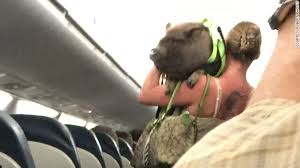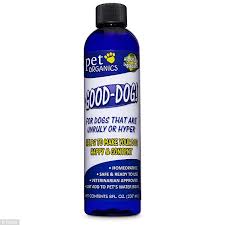A Flight Attendant's View of Service Animals
Heather Poole
 Since there is no real certification for service or emotional support animals, anything goes. Flight attendant Heather Poole was fed up with trying to make everybody happy. She questioned the credibility of "emotional support" pigs, horses and monkeys. Yes, these are the types of animals she's had the pleasure of accommodating on her LA to NY route, but she's pretty much seen it all and then some.
Since there is no real certification for service or emotional support animals, anything goes. Flight attendant Heather Poole was fed up with trying to make everybody happy. She questioned the credibility of "emotional support" pigs, horses and monkeys. Yes, these are the types of animals she's had the pleasure of accommodating on her LA to NY route, but she's pretty much seen it all and then some.
The ADA (American Disabilities Act) has made it so that if any business turns these service animals away, they may face a $10,000 fine. Airlines really do try to do everything they can to accommodate service and emotional support animals. They have to, it's the law. Not once has Heather seen an animal of any sort turned away.
Heather didn't make the determination as to whether or not an animal was a true service animal. She just received the paperwork so she knew exactly who was on board, including the number of pets and service animals. If the animal was not listed as a service animal, it was considered a pet and had to stay in its carrier.
Airlines do not charge a fee if an animal is a service animal. Normally, pets may be charged around $200 a flight, so there is the incentive for people to claim that their pet is a service animal. However, you do need proof that you have a service animal, which is not hard to do.
Heather noticed a lot more emotional support animals on board than ever before and the New York-to-Los Angeles route seemed to be the most popular one.
Heather told us that she loves animals and would actually prefer an airplane full of animals as opposed to humans! That's because they don't complain and are usually very sweet. Animals are quiet, they never complain about the food. They don't pull on her dress or yell at her when they run out of space for their bag.
 You can imagine the stories Heather can tell. One story she told us was about a male passenger who looked like he could be a boxer, as he had that big kind of muscular build. On the flight with him, he had his emotional support kitten. While she thought it was really cute, the lady next to him was allergic and didn't tell anyone until they were already in the air and there were no seats left.
You can imagine the stories Heather can tell. One story she told us was about a male passenger who looked like he could be a boxer, as he had that big kind of muscular build. On the flight with him, he had his emotional support kitten. While she thought it was really cute, the lady next to him was allergic and didn't tell anyone until they were already in the air and there were no seats left.
Some people don't like to sit near kids or near animals. It seems everyone has a problem and you can't please everyone!
A passenger even made headlines when she was kicked off a plane with her "emotional support" pig. A full-grown pig on a plane! Seems the pig caused a disruption, pooping right there in the aisle. The airline had allowed the passenger to board with it because it was an emotional support animal, and yes, a full-grown pig qualifies as an emotional support animal. So does a miniature horse. Heather said she could barely get 14 first-class coats to fit inside the closet on a Boeing 737, and had yet to run into a bulkhead row big enough to accommodate a horse.
On Heather's flights, she stated she's been lucky and hadn't had the abnormal service animals like pigs or miniature horses. But don't get her wrong, she feels people who need these animals should have them.
She told us that there was a Rooster that had flown frequently on flights and a duck that even got loose and ran up to first class and bit a passenger. There was another time when a service dog was growling at the flight attendants every time they walked by.
In training, they were taught how to evacuate a plane in 90 seconds, how to take down terrorists with their bare hands, how to put out fires and, of course, how to serve a five-course meal. But there was nothing about animal control!
Heather feels that everyone has to be in the flying tube together, so they all need to make it work. In these days, everyone seems to be in a "Me, me, me world" and it's all about their issues and problems. It's gotten so bad, there's not even enough space to bend over and reach into your bag without smushing your face against the seat in front of you. When she was rolling down the aisle with the cart and looked around, she felt your pain and did what she could to make people happy with the tools she had been provided, but it was impossible to please everyone.
Flying can feel like an episode of Survivor, which is why Heather thinks we should all do our part to make things go a little smoother. But perhaps people should think ahead, and if they are going to travel, get a service animal that can travel easily, not a barnyard animal, maybe perhaps maybe a Guinea Pig?
Visit Website
US Airline Apologizes to PTSD Sufferer
Veteran Eric Calley
 Former U.S. Marine Eric Calley suffers from Post Traumatic Stress Disorder (PTSD). He was quite thankful for his service dog, "Sun." However, Eric had a run-in with a US airline when they denied proper seating for his service dog and berated him with insults.
Former U.S. Marine Eric Calley suffers from Post Traumatic Stress Disorder (PTSD). He was quite thankful for his service dog, "Sun." However, Eric had a run-in with a US airline when they denied proper seating for his service dog and berated him with insults.
Eric Calley is a former U.S. Marine who served two tours in Iraq. Eric suffers from PTSD and Sun, a Doberman Pinscher, was his service dog. Eric also works as an advocate for fellow veterans who suffer from the affliction.
Eric explains that there are a lot of variations of PTSD and that it is not curable, it is only manageable. He states, "You have to manage it before it manages you."
Over the years, since his first tour in 2003 and his second tour in 2004/2005, Eric has learned how to cope. What has helped him do this were his service dogs. He states that service dogs do a huge wonder for veterans with PTSD, brain injuries and all different types of disabilities, including amputations and mobility functions.
Eric states that his service dog Sun was a Godsend. His first dog, Liberty, was a Red Doberman who was at Eric's side since he got out of the service until her passing. While most organizations told Eric it would be at least a year before he could get a new dog, Guardian Angels Service Dogs in Florida were contacted and provided Eric with Sun within six months.
Sun monitored his heart rate, his breathing and the tension in his muscles. If Sun noticed a change, she immediately nuzzled Eric with her nose to calm him. She also jumped in his lap to put warm pressure on his chest.
Seeing a need, Guardian Angels Medical Service Dogs created "Liberty's Legacy" in Michigan to bring service dogs from Florida to veterans, through fundraising. Eric told us that there are around 11,000 veterans a year that come back into Michigan and that a third of them will have PTSD or some variation of it.
Eric and Sun travelled to Florida frequently by plane and it was yet another case of someone not understanding what a service dog looks like. The pair were on a US airline flight from Florida to Detroit. Eric had troubles from the very beginning from trying to obtain a boarding pass and selecting a seat but it didn't end there. While on the flight, Sun, who was then relatively new to being a service dog, got a little scared after the wheels went up after takeoff. She was spooked and she jumped up in the vacant seat next to Eric. Eric didn't know she wasn't allowed in a seat, and two stewardesses walked by and said nothing, they even petted Sun. But one stewardess came to them and started yelling at Eric, stating that the dog couldn't be on the seat. Eric then had Sun go to the floor, but the Stewardess kept yelling for a time before she left.
Upon the descent of the plane, Sun once again got spooked. This time she put her paws on Eric's lap. This once again brought down the wrath of the stewardess.
At this point in time, the other passengers started to speak up and defended Eric and Sun. But the stewardess threatened to have the police waiting for Eric when he got off.
When Eric got off the plane, many passengers came up to him in his defense. There were about 15 people in a line waiting for him to get off the plane. They told him that they thought he was treated very badly by the airline.
A few weeks after the flight, Eric received an apology in the form of a letter from the airline. The letter said, "It appears our airport personnel didn't handle the situation with the quality customer care we expect." Eric stated that the problem was that they were not trained adequately on handling service dogs.
Eric spoke out about this to raise awareness on behalf of veterans and those with service animals. He stated that we are going to continue to have this huge influx of new veterans coming back. It can take a veteran four to five years after getting out to even attempt to get help. The thing he wants US airlines to understand is that this is going to be a growing problem.
Eric promotes Liberty's Legacy - a program helping veterans from Michigan to get service dogs. His goal is to bring "as many dogs as possible" to Michigan veterans.
Visit Website
"HERO PEOPLE OF THE WEEK" - Kristin Allen - Wildlife Rehabilitator
 Kristin Allen is a volunteer wildlife rehabilitator with the Kentucky Department of Fish and Wildlife. She rescues orphaned, sick, displaced or injured wild animals. Kristin houses them and arranges for veterinary medical care with the goal of releasing them back to their natural habitat. She has cared for hundreds of animals over the years.
Kristin Allen is a volunteer wildlife rehabilitator with the Kentucky Department of Fish and Wildlife. She rescues orphaned, sick, displaced or injured wild animals. Kristin houses them and arranges for veterinary medical care with the goal of releasing them back to their natural habitat. She has cared for hundreds of animals over the years.
Kristin Allen has loved animals since she was a young child. Before she was a wildlife rehabilitator, it seemed all of the animals found her.
Years ago she started rehabilitating wildlife and got her license. Originally she was only working with mammals. But when she rescued a red-tailed hawk, which had been hit by a car and was on the side of the road, things changed.
Kristin doesn't think that people understand that these injured birds can be saved. They seem to know about dog and cat rescues but aren't aware of agencies for rehabilitating wildlife. She said people don't know that if by chance an owl runs into your car, you don't have to leave it there on the side of the road to die. There are people who will take care of this animal and try to get it well enough to be released back in the wild. They will even give you information on how to treat and watch the animal until help arrives.
But how do you find these people? With everyone having a SmartPhone or access to the Internet, you just need to type in "Wildlife Rehabilitator" for the state you live in. You will usually be given a choice of a wildlife center or you will find a list of wildlife rehabilitators in the area.
For Kristin, rehabbing is a family affair, with her caring for many of these animals in her home. Her children, Adrienne, Grant, Madeline and Sophia, are all animal lovers and help with everything from feedings to vaccinations to cage cleaning. Her husband John is a pro at bottle washing.
Visit Website
 E-Cigarette Toxicity in Pets - Dr. Debbie
E-Cigarette Toxicity in Pets - Dr. Debbie
Think that vapor cigarettes (a.k.a. electric cigarettes or e-cigarettes) are a healthier alternative to traditional cigarettes? The vapor habit might be better for you and decrease your pet's exposure to second hand smoke, but can increase the chance of a pet's toxic ingestion of nicotine. A story from England told of the tragic death of a puppy that died after chewing on an e-liquid container.
Ivy was a 14-week on Staffordshire Bull Terrier that chewed on her owner's bottle of e-liquid used to refill the electric cigarettes. Within 30 seconds of nibbling on the container, she fell sick with vomiting and disorientation and was rushed to a veterinary office. Sadly, Ivy died within 24 hours due to heart and respiratory failure.
What's in e-liquid?
The ingredients in e-liquid vary but include carriers such as propylene glycol, polyethylene Glycol 400 and vegetable glycerin, as well as flavoring agents and nicotine. The amount of nicotine in e-liquid varies with some products not containing any nicotine, to others ranging from 18 mg/ml to 100mg/ml.
How toxic is nicotine?
The toxic dose of nicotine for pets is 0.5 to 1mg per pound of body weight. The fatal dose is 4mg per pound. So if you consider a 20 pound dog, toxicity would occur if 10mg were ingested, and the pet would die if 80mg were ingested. Therefore with the high nicotine levels in e-liquid, it wont take much to reach those fatal levels. That hypothetical 20 pound dog could die from less than 1ml of the highest potency liquid nicotine.
 Pets likewise can develop toxicity if other sources of nicotine are ingested such as cigarettes, chewing tobacco, nicotine gum or nicotine nasal sprays. The typical amounts of nicotine in these products are: Cigarette 9-30 mg; Nicotine gum 2-4 mg per pieces; and Nicotine patches 8.3-114 mg.
Pets likewise can develop toxicity if other sources of nicotine are ingested such as cigarettes, chewing tobacco, nicotine gum or nicotine nasal sprays. The typical amounts of nicotine in these products are: Cigarette 9-30 mg; Nicotine gum 2-4 mg per pieces; and Nicotine patches 8.3-114 mg.
Even cigarette butts can be toxic if enough are ingested - cigarette butts retain 25-percent of the nicotine in the original cigarette.
What are symptoms of nicotine poisoning?
Symptoms usually develop within one hour of ingestion. Pets may display excitability, rapid heart rate, drooling, vomiting, diarrhea, weakness, seizures and coma.
How are pets treated for nicotine toxicity?
The first step is to decontaminate by inducing vomiting. Nicotine typically causes vomiting when ingested, but further decontamination is advised at the veterinary office. Other emergency care includes intravenous fluids, medications to manage elevated blood pressure and heart rate and anti-seizure medications. Nicotine is metabolized by the liver and excreted within 16 hours after ingestion. Pets that survive the initial four hours after ingestion have a favorable chance of survival.
The vapor cigarette trend is becoming more popular world wide. It's important to recognize that nicotine is a toxin and poisonous to animals and children. Consider the e-liquid a hazardous material and store it safely in a locking cabinet, away from children and pets.
To read more about Ivy's toxicity after ingesting E-fluid go to "Dog dies after chewing e-fluid container."
Featured veterinarian known as "Dr. Debbie" on national pet radio program, Animal Radio. Ebook author of "Yorkshire Terriers: How to Be Your Dog's Best Friend"; "Pugs: How to Be Your Dog's Best Friend"; "Mini Schnauzers: How to Be Your Dog's Best Friend"; and "Shih Tzu: How to Be Your Dog's Best Friend." Dr. Debbie's books.
Visit Website
Animal Radio News - Tammy Trujillo
 Disabled Vet Evicted Over Unpaid Pet Fee
Disabled Vet Evicted Over Unpaid Pet Fee
We've been seeing more and more stories about the fees landlords charge people who move in with pets. An unpaid pet fee even resulted in a disabled Army Veteran and his service dog being evicted from a mobile home. The veteran served for seven years including tours in Iraq and Afghanistan with the Army and the National Guard. He refused to pay the pet fee, citing Section 504 of the Fair Housing Act that states service animals are not pets, so are not subject to a pet fee. He sufferred from a traumatic brain injury as well as damage to his neck, spine, knee and shoulder suffered in a Humvee accident and IED attack. He also is a cancer survivor. He says his red-heeler mix service dog helped him get through the day. When he was evicted from his mobile home, the pet fee had ballooned to $2,500 dollars. He said he fought it because if something like this happened to him, it could, and probably is, happening to other people.
 Would You Give Your Dog a Glass of Wine to Help Him Chill?
Would You Give Your Dog a Glass of Wine to Help Him Chill?
No matter how hyper your dog is, you would never give it an alcoholic drink to help it chill, would you? You might have done just that if you used the product Good Dog made by Pet Organics. It claimed to be a homeopathic way to calm down unruly dogs with 'all natural ingredients.' Turns out that among those 'natural ingredients' was 13-percent alcohol, about the same amount that is wine. A check with the Pet Poison Helpline stated that even a small amount of alcohol can be toxic for cats and dogs. Good Dog was supposed to be diluted in water and that if it was used as directed, it would not have a negative effect. In the years that the product was sold, there were no reports of deaths or illness. One veterinarian said this brings up a bigger problem, the fact that homeopathic drugs for pets are not regulated.
Hi-Tech Pet Products
The Consumer Electronics Show was in Las Vegas a few months ago, and while all kinds of companies showed off their products aimed at health and entertainment and such, some pretty interested pet-related items were unveiled as well. Among them, Oro's AI-powered pet robot that takes care of your pet while you're away. It lets you check in on your pup with two-way audio and interactive video and also dispenses treats or food. The robot retails for $799 and will begin shipping in April. Another product is Invoxia's Smart Dog Collar that lets you track your pup's movement, heart rate and more. You can use the data the collar provides to give to your vet for diagnostic purposes and catch diseases early before they become severe. This pet wearable costs $149. For the hi-tech birder, the Birdfy's Bird Feeder gives you realtime data about the birds in your yard. When a bird visits the feeder, the Birdie app will notify you of the feathered visitor landing, show you a video feed and help identify the bird species for you. The Birdfy Feeder costs $170.
 Cover Your Pet's Private Parts With "Rear Gear"
Cover Your Pet's Private Parts With "Rear Gear"
Rear Gear was made by a company in Portland Oregon and was basically a tag that hung on your dog or cat's tail to cover up their rear. The company's slogan was "No More Mr. Brown Eye." It also claimed to help boost your pet's confidence. The tags came with a variety of pictures on them including cupcakes, disco balls and biohazard symbols.
 Listen to the entire Podcast of this show (#1268)
Listen to the entire Podcast of this show (#1268)





